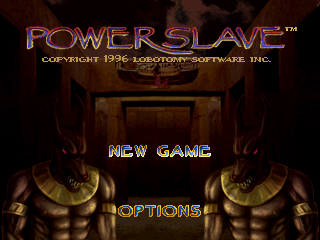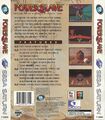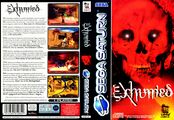Difference between revisions of "Powerslave"
From Sega Retro
m (Text replacement - "consolescompilation" to "originalsystem") |
|||
| Line 61: | Line 61: | ||
==Production credits== | ==Production credits== | ||
===''Powerslave'' and ''Seireki 1999: Pharaoh no Fukkatsu''=== | ===''Powerslave'' and ''Seireki 1999: Pharaoh no Fukkatsu''=== | ||
| − | + | TODO: there's a paragraph after the credits row of the Japanese version, translate/check if it's relevant | |
{{multicol| | {{multicol| | ||
{{creditstable| | {{creditstable| | ||
| Line 80: | Line 80: | ||
*'''Additional Technical Support:''' Kurt Pfeifer, John Yuill, Paul Hagerud, John Schwab, Pat Schreiber | *'''Additional Technical Support:''' Kurt Pfeifer, John Yuill, Paul Hagerud, John Schwab, Pat Schreiber | ||
*'''Instruction Manual:''' Tom Kristensen | *'''Instruction Manual:''' Tom Kristensen | ||
| − | *'''Lobotomy Would Like to Thank:''' Jacqui Lyons, [[Marjacq Micro]], PIE, [[Tommy Tellarico]], Cheryl Hart, [[SEGA]] | + | *'''Lobotomy Would Like to Thank:''' Jacqui Lyons, [[Marjacq Micro]], PIE, [[Tommy Tallarico|Tommy Tellarico]], Cheryl Hart, [[SEGA]] |
{{creditsheader|Playmates Interactive Entertainment}} | {{creditsheader|Playmates Interactive Entertainment}} | ||
*'''Executive Producer:''' David Luehmann | *'''Executive Producer:''' David Luehmann | ||
Revision as of 19:51, 27 October 2018
| Powerslave | |||||||||||||||||||||||||
|---|---|---|---|---|---|---|---|---|---|---|---|---|---|---|---|---|---|---|---|---|---|---|---|---|---|
| System(s): Sega Saturn | |||||||||||||||||||||||||
| Publisher: BMG Interactive, Playmates Interactive Entertainment (US) | |||||||||||||||||||||||||
| Developer: Lobotomy Software | |||||||||||||||||||||||||
| Original system(s): PC | |||||||||||||||||||||||||
| Sound driver: SCSP/CD-DA (13 tracks) | |||||||||||||||||||||||||
| Peripherals supported: Saturn 6 Player Adaptor (for Death Tank) | |||||||||||||||||||||||||
| Genre: Action | |||||||||||||||||||||||||
| Number of players: 1 (2-6 for Death Tank) | |||||||||||||||||||||||||
| |||||||||||||||||||||||||
Powerslave, known as Exhumed in Europe and Seireki 1999: Pharaoh no Fukkatsu (西暦1999 ファラオの復活) in Japan, is a first person shooter game developed by Lobotomy Software and released for the Sega Saturn in 1996.
Contents
Gameplay
Death Tank
The North American and Japanese versions of Powerslave contain a mini game called Death Tank that can be accessed if you collect all 23 dolls hidden in the game. The mini-game supports up to 6 players, which was increased up to 7 players in it's sequel, Death Tank Zwei, which can be found in Duke Nukem 3D.
History
Slave Driver game engine
The original version appeared on the PC as a Build engine game and featured many mechanics, levels and content that varied differently. This includes linear level design, in-game speech from the main character, and stock lives that once they've run out, the game ends for the player. When the game was brought to the Sega Saturn and PlayStation, the game was rebuilt from the ground up using a proprietary engine called Slave Driver which was able to render more complex levels, including rooms above other rooms, which was not possible on the Build engine. It also went through a major gameplay re-design thanks to the stronger hardware. The PlayStation and Sega Saturn versions put more focus on exploration and allow the player to replay stages. In order to progress, certain permanent power ups (e.g. magic sandals that allow higher jumps) need to be collected. The Slave Driver engine would become a framework for PC to console ports by Lobotomy Software including Duke Nukem 3D and Quake.
Versions
Powerslave was released on the Sega Saturn several months before its PlayStation counterpart, and for its time was a technical showpiece for the system. With better 3D performance, the PlayStation is able to add more visual effects, true transparency (negating the need for the checkerboard "mesh" pattern used for water), and performance improvements in some areas.
While the Saturn version is capped at 30FPS, the PlayStation can reach highs of 60FPS. As was common for 3D games at the time, however, both versions struggle to hold their desired numbers - the Saturn dropping to 20FPS in more hectic scenes, and the PlayStation also dropping to 30 or 20FPS on occasion. The Saturn version, while slower in this regard, is therefore able to output a more consistent frame rate, with its PlayStation counterpart being noticeably more variable as more frames are dropped.
The PlayStation version is also able to offer better lighting effects, however much of its level geometry has been paired back, with smaller, less complicated rooms being used throughout the experience (and some larger rooms being split up). While a new introduction area is added, several areas lose the sense of scale, to the point where some outdoor areas on the Saturn are indoors on the PlayStation.
The auto-aiming feature of the Saturn version of Powerslave is less effective on the PlayStation, making it harder to hit smaller targets. Also missing is any form of analogue control - while Saturn Powerslave supports the 3D Control Pad, neither Dual Analog or DualShock controllers are supported on Sony's machine.
Reportedly the red spiders were changed to blue scorpions to satisfy Sony's desire for PlayStation games to have unique content when ported from other platforms.
On the PC, Powerslave is an entirely different game, and while many assets are shared between the three versions, the PC has unique levels designed for the Build engine (which on the PC is most notable for powering Duke Nukem 3D, as well as Shadow Warrior and Blood). Powerslave uses an earlier version of the engine than Duke 3D, however, so there are no slopes in the game, and is much more linear in design than is console counterparts.
Death Tank is exclusive to the Saturn version of Powerslave.
Localised names
| Language | Localised Name | English Translation |
|---|---|---|
| English | Exhumed | Exhumed |
| English (US) | Powerslave | Powerslave |
| Japanese | 西暦1999 ファラオの復活 | Seireki 1999: Pharaoh no Fukkatsu |
Production credits
Powerslave and Seireki 1999: Pharaoh no Fukkatsu
TODO: there's a paragraph after the credits row of the Japanese version, translate/check if it's relevant
- Executive Producers: Brian McNeely, Paul Lange
- Game Design and Art Direction: Brian McNeely
- Game Programming: Ezra Dreisbach
- BREW World Editing Tool: David Lawson
- Music and Sound Effects: Scott Branston
- Design Team: Brian McNeely, Dominick Meissner, Ezra Dreisbach, Paul Knutzen, Paul Lange, Mark Coates, Jason Wiggin
- Texture and Ambient Object Art: Troy Jacobson, Joe Kresoja
- Creatures and Weaponry: John Van Deusen
- 3D Modeling: Kevin Chung, William Vallieres
- Cinema Scene and Map Art: Richard Nichols, John Van Duesen
- Art Team: Brian McNeely, Troy Jacobson, John Van Duesen, kevin Chung, Paul Knutzen, Richard Nichols, Erik Klokstad, William Vallieres, Joe Kresoja, Jason Wiggin
- Stage Design: Brian McNeely, Dominick Meissner, Paul Knutzen
- Object and Ambient Light Editing Tool: Jeff Blazier
- Peepshow Animation Tool: Paul Schreiber
- Additional Technical Support: Kurt Pfeifer, John Yuill, Paul Hagerud, John Schwab, Pat Schreiber
- Instruction Manual: Tom Kristensen
- Lobotomy Would Like to Thank: Jacqui Lyons, Marjacq Micro, PIE, Tommy Tellarico, Cheryl Hart, SEGA
- Executive Producer: David Luehmann
- Producer: Chris Archer
- Associate Producer: Carlos Rodriguez
- QA Manager: Rich Frey
- Lead Tester: Andrew, A. Brown
- Testers: David Ontiveros, Lee Jones, David Arranaga, James Martinez, Anthony Vasquez, Jose Zatarain, Leland Mah
- Sales Marketing: David Localio, Kelly Frey
- Technical Support: Jose Zatarain, Lee Jones
- PR: Ron Antonette, Nicole Rosenberg, Karen Trachtenberg
- Special Thanks: Richard Sallis, Thomas Chan, Sue Lucchino, Dabvid L. Hoffman, Scott Herrington, Playmate Toys
Exhumed
- Executive Producers: Brian McNeely, Paul Lange
- Game Design: Brian McNeely
- Additional Game Design: Dominick Meissner, Mark Coates, Jason Wiggin, Ezra Dreisbach
- Game Programming: Ezra Dreisbach
- BREW World Editing Tool: David Lawson
- Art and Environment: Troy Jacobson, Brian McNeely, John Van Deusen, Kevin Chung, Paul Knutzen, Richard Nichols, Eric Klokstad, Joe Kresoja, Jason Wiggin, Willian Vallieres
- Creatures and Weaponry: John Van Deusen
- Music and Sound Effects: Scott Branston
- Stage Design: Brian McNeely, Dominick Meissner, Paul Knutzen, Jason Wiggin, Mark Coates
- Additional Technical Support: Jeff Blazier, John Schwab, John Yuill, Paul Hagerud, Paul Schreiber, Pat Schreiber, Kurt Pfeifer
- Instruction Manual: Tom Kristensen
- Special THANKS! to: Jacqui Lyons, Marjacq Micro, Ian Mathias, Mike Brown, Ronya, Lonnie, Nasie, and of Course Sega
Magazine articles
- Main article: Powerslave/Magazine articles.
Promotional material
also published in:
- Next Generation (US) #22: "October 1996" (1996-09-17)[3]
- Electronic Gaming Monthly (US) #87: "October 1996" (1996-xx-xx)[4]
- EGM² (US) #29: "November 1996" (1996-xx-xx)[5]
Artwork
Physical scans
| 85 | |
|---|---|
| Based on 34 reviews | |
Technical information
ROM dump status
| System | Hash | Size | Build Date | Source | Comments | |||||||||
|---|---|---|---|---|---|---|---|---|---|---|---|---|---|---|
| ✔ |
|
570,672,816 | CD-ROM (EU) | 81084-50 V1.000 | ||||||||||
| ✔ |
|
524,049,120 | 1996-10-02 | CD-ROM (JP) | T-18001G V1.003 |
Save data
Powerslave makes use of the Saturn's internal battery back-up as well as the Saturn Backup Memory to save data for progress. To load and save data from the Ram Cart, the save file must be created on the internal battery back-up first, then moved over via the Memory Manager.
| Name | Comment | File Size |
|---|---|---|
| POWERSLAVE# | save games | 11 |
References
- ↑ File:CVG UK 179.pdf, page 53
- ↑ 2.0 2.1 2.2 File:CVG UK 178.pdf, page 72 Cite error: Invalid
<ref>tag; name ":File:CVG UK 178.pdf_p72" defined multiple times with different content - ↑ Next Generation, "October 1996" (US; 1996-09-17), page 195
- ↑ Electronic Gaming Monthly, "October 1996" (US; 1996-xx-xx), page 43
- ↑ EGM², "November 1996" (US; 1996-xx-xx), page 67
- ↑ 6.0 6.1 File:GameFan US 0411.pdf, page 18 Cite error: Invalid
<ref>tag; name ":File:GameFan US 0411.pdf_p18" defined multiple times with different content - ↑ File:HobbyConsolas ES 061.pdf, page 70
- ↑ 8.0 8.1 File:Joypad FR 057.pdf, page 98 Cite error: Invalid
<ref>tag; name ":File:Joypad FR 057.pdf_p98" defined multiple times with different content - ↑ 9.0 9.1 File:MegaForce FR 54.pdf, page 36 Cite error: Invalid
<ref>tag; name ":File:MegaForce FR 54.pdf_p36" defined multiple times with different content - ↑ File:MegaFun DE 1996-10.pdf, page 76
- ↑ 11.0 11.1 File:MeanMachinesSega47UK.pdf, page 52 Cite error: Invalid
<ref>tag; name ":File:MeanMachinesSega47UK.pdf_p52" defined multiple times with different content - ↑ 12.0 12.1 File:PlayerOne FR 068.pdf, page 92 Cite error: Invalid
<ref>tag; name ":File:PlayerOne FR 068.pdf_p92" defined multiple times with different content - ↑ 13.0 13.1 File:SSM UK 11.pdf, page 68 Cite error: Invalid
<ref>tag; name ":File:SSM UK 11.pdf_p68" defined multiple times with different content - ↑ 14.0 14.1 File:SSM JP 19961213 1996-21.pdf, page 269 Cite error: Invalid
<ref>tag; name ":File:SSM JP 19961213 1996-21.pdf_p269" defined multiple times with different content - ↑ 15.0 15.1 Saturn no Game wa Sekai Ichi~i~i~i!: Satamaga Dokusha Race Zen Kiroku, SoftBank Publishing, page 11 Cite error: Invalid
<ref>tag; name ":File:SnGwSISDRZK Book JP.pdf_p11" defined multiple times with different content - ↑ File:VideoGames DE 1996-10.pdf, page 83
- ↑ 576 KByte, "Október 1996" (HU; 1996-xx-xx), page 26
- ↑ Electronic Gaming Monthly, "December 1996" (US; 1996-xx-xx), page 85
- ↑ Famitsu, "1996-12-06" (JP; 1996-11-22), page 1
- ↑ Freak, "3/97" (IL; 1997-xx-xx), page 1
- ↑ Fun Generation, "11/96" (DE; 1996-10-09), page 78
- ↑ Gambler, "4/1997" (PL; 1997-xx-xx), page 1
- ↑ GamePro, "November 1996" (US; 1996-xx-xx), page 120
- ↑ GamesMaster, "September 1996" (UK; 1996-08-01), page 51
- ↑ Game Informer, "December 1996" (US; 1996-1x-xx), page 65
- ↑ Gry Komputerowe, "1-2/1997" (PL; 1997-xx-xx), page 1
- ↑ Hobby Consolas, "Octubre 1996" (ES; 1996-xx-xx), page 68
- ↑ LeveL, "Prosinec 1996" (CZ; 1996-12-01), page 82
- ↑ MAN!AC, "11/96" (DE; 1996-10-09), page 74
- ↑ Mega Fun, "10/96" (DE; 1996-09-18), page 60
- ↑ Saturn Fan, "1996 No. 24" (JP; 1996-11-15), page 188
- ↑ Saturn Fan, "1997 No. 2" (JP; 1997-01-17), page 70
- ↑ Saturn+, "Issue 4" (UK; 1996-10-24), page 28
- ↑ Score, "Prosinec 1996" (CZ; 1996-12-01), page 112
- ↑ Secret Service, "Marzec 1997" (PL; 1997-xx-xx), page 67
- ↑ Sega News, "Listopad 1996" (CZ; 1996-1x-xx), page 10
- ↑ Sega Power, "September 1996" (UK; 1996-08-01), page 34
- ↑ Świat Gier Komputerowych, "2/1997" (PL; 1997-xx-xx), page 1
- ↑ Total Saturn, "Volume One Issue Two" (UK; 1996-09-30), page 58
- ↑ Total Saturn, "Volume One Issue Four" (UK; 1996-12-29), page 25
- ↑ Video Games, "10/96" (DE; 1996-09-25), page 86
- Pages with reference errors
- 2 player games
- 1 player games
- JP Saturn games
- All JP games
- US Saturn games
- All US games
- EU Saturn games
- All EU games
- AU Saturn games
- All AU games
- Saturn games
- 1996 Saturn games
- All 1996 games
- Saturn action games
- All action games
- Old content rating field
- All games
- Bad translation
- Credits without reference
- GalleryPrintAd file defined
- Old-style rating (cvg)
- Use magref
- Old-style rating (famitsu)
- Rating without PDF source
- Old-style rating (gamefan)
- Old-style rating (gamesmaster)
- Old-style rating (hobbyconsolas)
- Old-style rating (joypad)
- Old-style rating (megaforce)
- Old-style rating (megafun)
- Old-style rating (mms)
- Old-style rating (playerone)
- Old-style rating (segapower)
- Old-style rating (ssm)
- Old-style rating (ssmjp)
- Old-style rating (ssmjp r)
- Old-style rating (videogames)
- Update ratings template
- 15 old ratings
- Missing ROM hashes
- Old technical information











